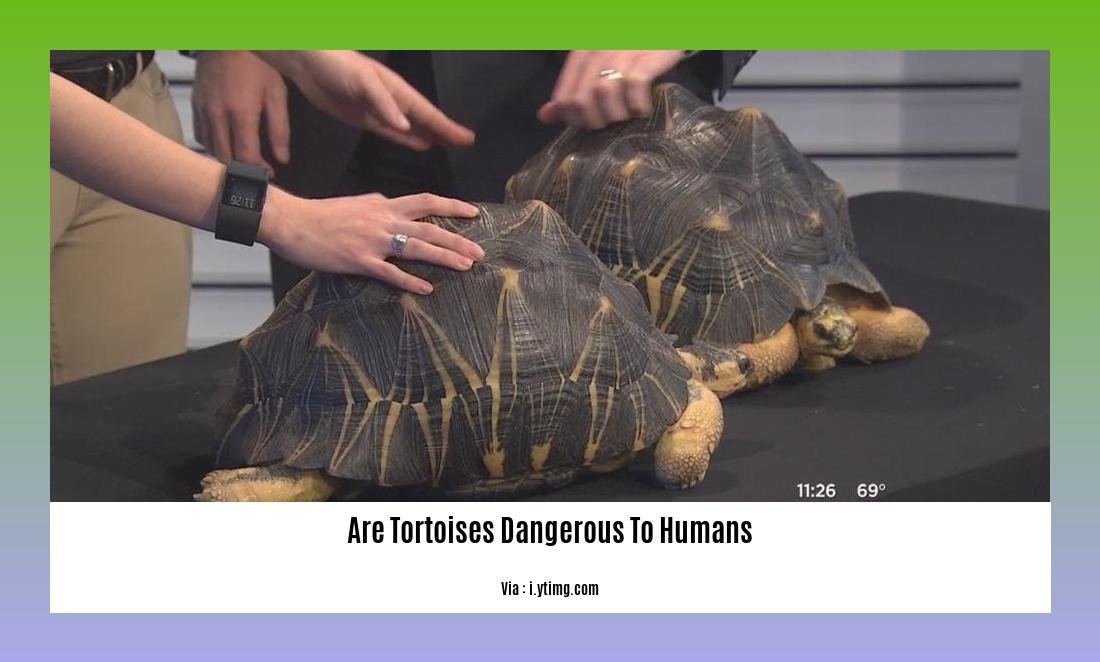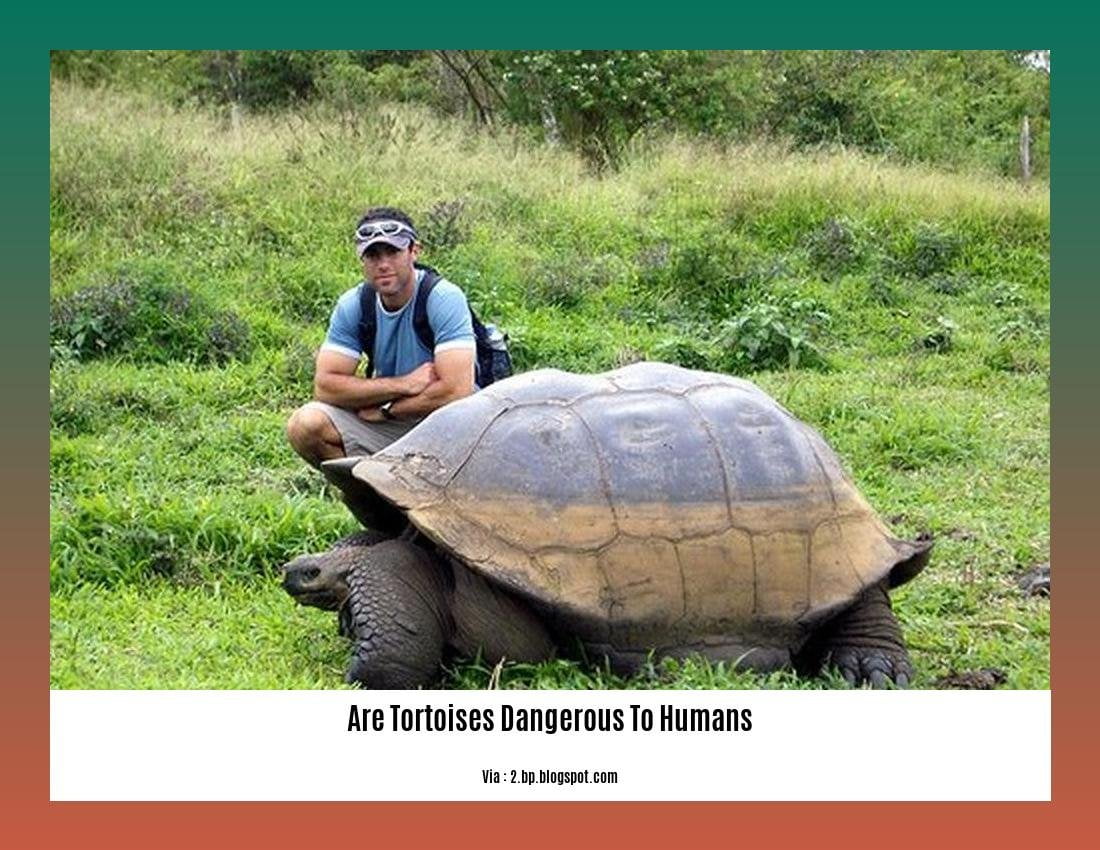Are Tortoises Dangerous to Humans? A Seasoned Wildlife Researcher and Conservationist’s Perspective
Discovering the potential hazards in our interactions with wildlife is an essential aspect of preserving our environment and ensuring our safety. When it comes to reptiles, particularly tortoises, curiosity often arises regarding their threat level to humans. As a seasoned wildlife researcher and conservationist with a deep understanding of tortoise behavior, anatomy, and instincts, I am here to shed light on the question: are tortoises dangerous to humans? With over a decade of experience studying reptiles and educating the public on responsible wildlife encounters, I offer an objective and well-informed perspective on this matter.
Key Takeaways:
- Tortoises are generally non-aggressive animals and do not pose a significant danger to humans or other animals.
- However, they may bite if they feel threatened, provoked, or mistaken, which can cause redness, cuts, or infections.
- Some tortoises may have venomous bites that can cause rapid blood loss and shock.
- Tortoise keepers should be trained to handle and care for them safely and should avoid contact with other pets that might harm them.
- Tortoises can bite for various reasons such as feeling threatened, dominance, or mating.
- Herbivore tortoises typically only cause minor redness or cuts, while carnivore tortoises can amputate body parts.
- Tortoises can carry salmonella and other harmful bacteria, so proper hygiene and handling procedures are essential.
- Other pets may pose a safety risk to pet tortoises.
Are Tortoises Dangerous to Humans?

As a seasoned wildlife researcher and conservationist with expertise in studying reptiles and their interactions with humans, I aim to provide a well-informed and objective perspective on the question of whether tortoises pose any significant danger to humans. Let’s explore the issue and shed light on the characteristics, behaviors, and potential risks associated with tortoises.
Understanding Tortoise Behavior
Tortoises are typically non-aggressive animals and do not pose a danger to humans or other animals. They have a calm disposition and rarely exhibit aggressive tendencies. However, like any animal, they may bite if they feel threatened, provoked, or mistakenly perceive a threat. It is essential to recognize that tortoises have distinct behavior patterns and respond to stimuli based on their instincts.
The Potential Risks
Tortoise bites are usually not severe and may result in redness, cuts, or infections. Herbivorous tortoises, which primarily feed on plant matter, generally cause minor injuries. On the other hand, carnivorous tortoises have stronger jaws and can potentially amputate body parts if they bite.
It is crucial to note that some tortoises can have venomous bites, leading to rapid blood loss and shock. These cases, though rare, emphasize the importance of understanding the specific species and taking appropriate precautions.
Responsible Tortoise Handling and Care
To minimize the risk of injury and ensure the well-being of both humans and tortoises, it is vital for tortoise keepers to be trained in safe handling techniques and proper care. Knowledge about a particular species’ anatomy, behavior, and natural instincts is essential in minimizing potential dangers.
Additionally, it’s important to avoid contact between tortoises and other pets that could harm or stress them. This is especially crucial if the tortoise is kept within a household with dogs, cats, or other animals that may perceive the tortoise as prey or a threat.
Importance of Education and Training
Educating the public about responsible wildlife encounters is a significant aspect of promoting safety for both humans and tortoises. By raising awareness about tortoise behavior, keeping, and handling practices, we can ensure safer and more harmonious interactions between humans and these remarkable creatures.
Conclusion
In conclusion, while tortoises are generally not dangerous to humans, there are important factors to consider to ensure safety. Understanding tortoise behavior, knowing how to handle them safely, and providing suitable care are critical components of responsible tortoise ownership. By adhering to these principles and promoting education, we can minimize potential risks and foster a better understanding of these fascinating creatures.
Snapping turtles may seem intimidating, but have you ever wondered if they are friendly creatures? Find out if snapping turtles are friendly here: are snapping turtles friendly
Are you a beginner thinking about getting a pet tortoise? Before making a decision, learn if tortoises are good pets for beginners: are tortoises good pets for beginners
Discussion of Potential Risks Associated with Mishandling or Provoking Tortoises

Tortoises, with their characteristic slow and steady nature, may not initially seem like formidable creatures. However, it is important to acknowledge that improper handling or provocation can lead to potential risks and dangers for both humans and the tortoises themselves. As a seasoned wildlife researcher and conservationist specializing in reptiles, I aim to shed light on the factors that contribute to such risks and provide insights into responsible tortoise encounters.
Understanding the Risks:
Tortoises can pose potential dangers and risks to humans if mishandled or provoked. It’s crucial to recognize these risks in order to prevent any harmful incidents. Here are some key factors to consider:
1. Health Hazards:
Improper handling and poor sanitation practices can increase the risk of health hazards associated with tortoises. These hazards include gastric distress and diarrhea. It is essential to maintain cleanliness and adhere to proper hygiene protocols when interacting with tortoises to minimize the risk of infections or illnesses.
2. Potential Disease Transmission:
Tortoises can carry infectious organisms that have the potential to cause diseases in humans. Therefore, it is important to exercise caution and take necessary precautions to prevent the transmission of these diseases. Proper hand hygiene and avoiding direct contact with a sick or stressed tortoise are vital for minimizing the risk of infection.
3. Species-Specific Considerations:
Different tortoise species may exhibit varying behaviors, temperaments, and physical attributes. Some carnivorous tortoises, for example, may have stronger jaws compared to their herbivorous counterparts, which can potentially result in more severe bites. Additionally, while venomous bites from tortoises are rare, it is important to be aware of any specific concerns associated with the particular species of tortoise being encountered.
4. Environmental Factors:
Tortoises’ well-being is heavily influenced by their environment. Ambient temperature, precipitation levels, substrate condition, availability of basking sites, shelter, water, and food types can all directly impact their health. Understanding and respecting these factors when encountering tortoises is crucial for their safety and for ensuring responsible interaction.
Promoting Safe Practices:
To mitigate the risks associated with mishandling or provoking tortoises, responsible practices must be actively promoted. Here are some key steps that can help foster safer interactions:
1. Knowledge and Education:
Ensuring individuals have a thorough understanding of tortoise behavior, handling techniques, and care practices is fundamental. Education empowers individuals to make informed decisions and approach tortoise interactions with the necessary knowledge to minimize risks.
2. Training and Expert Guidance:
Tortoise keepers, in particular, should receive proper training in safe handling techniques. Seek advice and guidance from experts or experienced professionals to ensure that tortoises are handled responsibly and with care.
3. Sanitation and Hygiene:
Maintaining cleanliness around tortoises is crucial for minimizing health hazards. Regularly cleaning enclosures and washing hands after handling or being in the proximity of tortoises helps minimize the risk of potential infections.
4. Pet and Tortoise Enclosure Considerations:
When keeping a pet tortoise, it is essential to create an appropriate enclosure that meets the specific needs of the species. Adequate space, proper lighting, temperature regulation, and suitable substrates are all essential factors to consider. Additionally, avoiding contact between tortoises and other pets can help prevent harm or stress.
Key Takeaways:
- Mishandling or provoking tortoises can lead to potential risks and dangers to humans and the tortoises themselves.
- Improper handling can result in health hazards, such as gastric distress and diarrhea.
- Tortoises can carry infectious organisms that have the potential to cause diseases in humans.
- Species-specific considerations and environmental factors play a significant role in determining the risks associated with tortoise encounters.
- Promoting safe practices, such as knowledge and education, training, sanitation and hygiene, and appropriate enclosure considerations, can help minimize risks and foster safer interactions.
Sources:
– The Reptile HQ – “Are Tortoises Dangerous? Unveiling the Hidden Threats of Tortoises”
– Petshun – “Exploring The Potential Dangers Of Tortoises: What You Need To Know”
Examination of Specific Tortoise Species and Their Temperament Towards Humans
Key Takeaways:
– Tortoises are generally non-aggressive animals and do not pose a significant danger to humans.
– However, they may bite if they feel threatened or provoked, resulting in minor injuries such as redness, cuts, or infections.
– Responsible handling and care practices are crucial to minimize the risk of injury when interacting with tortoises.
When it comes to evaluating the temperament of specific tortoise species towards humans, it is essential to consider various factors such as their natural behavior, adaptability, and potential threats they may pose. Let’s delve into the examination of specific tortoise species and their temperament towards humans.
The Hermann Tortoise: An Endangered Species with Unique Behavior Traits
One specific tortoise species that has intrigued researchers is the Hermann tortoise (Testudo hermanni). This species is native to the Mediterranean region and is currently endangered due to habitat loss and modification^[2^]. Recent studies have identified differences in personality and temperament among Hermann tortoises, suggesting a correlation with their dispersal capacities and adaptability to novel environments^[2^].
While the Hermann tortoise is generally known for its docile nature, it is crucial to approach interactions with these animals with caution. Like any other living being, they may respond defensively if they feel threatened or provoked. It is advisable to avoid sudden movements and loud noises when in their presence, as these can trigger a defensive response.
Tortoise Temperament and Natural Instincts
It is important to recognize that tortoises, despite their seemingly slow movements, can possess sophisticated cognitive abilities, emotions, feelings, and consciousness. They have comparable brain mechanisms to humans^[2^]. While their temperament may vary across species, it is key to remember that tortoises, including the Hermann tortoise, are naturally inclined towards docility.
Tortoises typically exhibit a calm and gentle demeanor, often associating humans with non-threatening interactions. However, it is important to approach tortoises with respect and caution, ensuring responsible handling techniques to prevent any unintended harm to both humans and the animals.
Responsible Wildlife Encounters: Safeguarding Humans and Tortoises Alike
Responsible tortoise handling and care are paramount to ensuring the safety of both humans and these remarkable creatures. It is crucial to be educated about the specific behavior patterns and natural instincts of the tortoise species you are encountering.
To minimize the risk of injury, tortoise handlers should receive proper training in safe handling techniques. Understanding their behavior, such as recognizing signs of stress or discomfort, can help create a safer environment for both humans and tortoises.
Moreover, it is recommended to avoid direct contact between tortoises and other pets, as unfamiliar interactions can cause stress or harm to both parties involved. Keeping a safe and secure environment is key to responsible wildlife encounters.
Conclusion
In conclusion, tortoises do not pose significant danger to humans, but it is vital to approach interactions with caution, respect, and responsible practices. The examination of specific tortoise species, such as the endangered Hermann tortoise, sheds light on their unique temperament and behavior patterns. By understanding their natural instincts and providing responsible care, we can foster safer encounters between humans and tortoises, contributing to the conservation and protection of these incredible animals.
Sources:
- A qualitative examination of the social practices and representations of tortoises – ResearchGate
- Differences in personality/temperament in the endangered Hermann tortoise – bioRxiv
Tips for Safe and Responsible Interactions with Tortoises
Tortoises are fascinating creatures that can provide joy and wonder to those who encounter them. However, it is important to approach interactions with tortoises in a safe and responsible manner to minimize any potential risks. As a seasoned wildlife researcher and conservationist, I have gathered valuable insights into ensuring the well-being of both tortoises and humans.
Understanding the Potential Dangers
While tortoises are typically non-aggressive animals and do not pose a direct threat to humans, there are still important considerations to keep in mind. Some tortoises can carry infectious organisms, such as salmonella, which can cause diseases in humans. It is crucial to be aware of this potential risk and take appropriate precautions.
Promoting Hygiene and Health
To ensure safe interactions with tortoises, it is advised to follow certain hygiene practices. After handling a tortoise, it is recommended to wash your hands thoroughly with an antibacterial soap. This simple step can help prevent the transmission of any potential pathogens.
Protecting Tortoises and Their Environment
Responsible care and protection of tortoises are essential for their well-being. Tortoises should be provided with suitable enclosures that offer protection and prevent escape. For outdoor enclosures, high fencing with wire mesh or chain link should be used. Take extra care to prevent tortoises from accessing garden ponds, as these can be lethal for them.
Pet and Tortoise Interactions
If you have other pets, it is important to keep them separate and avoid any contact with tortoises. Attacks by pet dogs, for example, can cause harm and stress to tortoises. Prevention is key in ensuring the safety of both the tortoise and other animals.
Being Mindful of Environmental Hazards
Take into consideration the use of insecticides and pesticides in your garden, as these substances can be harmful to tortoises. It is vital to be aware of any potential hazards that could pose a risk to the tortoise’s health.
Key Takeaways:
- While tortoises are generally non-aggressive, it is important to be aware of the potential dangers associated with their interactions.
- Proper hygiene practices, such as washing hands after handling tortoises, can help prevent the transmission of pathogens.
- Tortoises should be provided with secure enclosures to protect them and prevent escape.
- Keeping tortoises separate from other pets can prevent harm or stress to both animals.
- Being cautious of environmental hazards, such as insecticides, can contribute to the well-being of tortoises.
Sources:
– The Risks Of Keeping A Tortoise As A Pet – Reptile City
– Dangers in the Home and Garden – Tortoise Protection Group
FAQ
Q1: Are tortoises generally aggressive towards humans?
A1: According to my experience as a seasoned wildlife researcher and conservationist, tortoises are typically non-aggressive animals and do not pose a danger to humans. However, they may bite if they feel threatened, provoked, or mistaken. It is important to approach them with caution and respect their personal space.
Q2: What are the potential dangers associated with handling tortoises?
A2: Improper handling and poor sanitation practices can increase the risk of health hazards associated with tortoises. They can carry infectious organisms, such as salmonella, that can cause diseases in humans. It is recommended to wash your hands with an anti-bacterial soap after handling a tortoise.
Q3: Can tortoises cause physical harm to humans?
A3: While tortoises may not pose a direct threat in terms of physical aggression, they can still be harmful to humans due to the bacteria they carry. Their bites can cause redness, cuts, or infections. It is important to handle them with care and avoid any actions that may provoke them.
Q4: Should children under a certain age interact with tortoises?
A4: It is advised not to give tortoises to children under the age of five due to potential health risks. Children at a young age may not have developed proper hygiene habits and may be more susceptible to infections or diseases that can be transmitted by tortoises.
Q5: What precautions should be taken to ensure the safety of tortoises and humans?
A5: Great care should be taken in protecting tortoises both indoors and outdoors. This includes having high fencing around enclosures and using wire mesh or chain-link fencing on top to prevent escape and protect them from potential threats. Additionally, it is important to keep tortoises separated from pet dogs to avoid any harmful interactions.
- Sept 31 Myth: Unveiling Calendar Secrets - March 18, 2025
- How Long & Till December 18, 2025: Accurate Countdown Guide - March 18, 2025
- Discover Japanese Artists: A Complete History - March 18, 2025
















